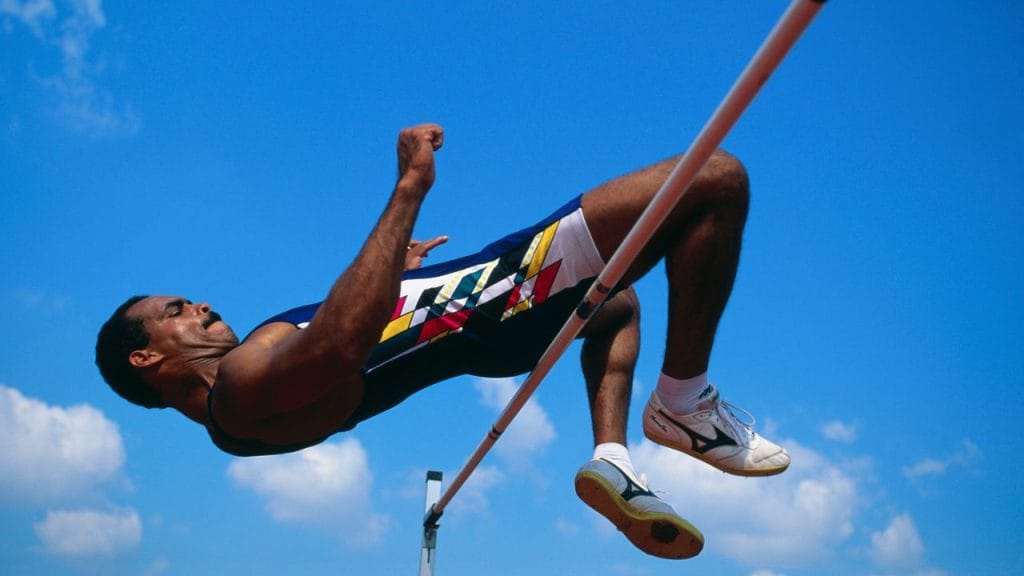
Another pro tip: “When it comes to jump training, I like to focus on unilateral movements, which means working one side of the body at a time,” says Washington. “So that could be single-leg step-ups, single-leg lunges—anything single-leg is really going to [help] increase our vertical jump simple because, when we’re working one leg at a time, we’re able to really build up that strength for our take-off.”
Exercises for Jumping Higher
Now for the meat and potatoes. What specific moves can help you jump higher?
Power exercises
For power training, Antoni recommends plyometrics (exercises that involve explosive movement, usually different types of jumps, skips, and hops) and ballistic exercises (training in which an “external load is projected into a flight phase”—most often throwing or swinging a weighted object).
There are a lot of options for power exercises, says Gambino, but “the key is that these are things that allow you to move fast.”
Some examples of power exercises that can help with jumping higher include:
- Sprinting
- Jump squats
- Box jumps
- Medicine ball throws
- Kettlebell work
Speed exercises
Zooming in a little, there are two buckets of speed exercises that can help increase your power.
“Speed-strength is an exercise with no weight, done quickly—like fast squats, fast pushups, fast jumping up and down,” says Antoni. “And then you’ve got strength-speed, which is those exercises, but under stress.” Examples of strength-speed exercises include using a light load (or small weight) during squats or jumps.
Strength exercises
We’ll get to the lower-body exercises, I promise—but not until we talk about your core. “Where most of our power stability [for jumping] comes is through the trunk,” says Antoni.
When it comes to core work, think beyond the crunch. Antoni recommends plank variations, including side planks, which work the obliques, while Washington says his go-to exercise for a stronger core is the Pallof press.
When building strength in your lower body to help you jump higher, Gambino breaks the movement down into two main parts: the squat and the hinge at the hips.
According to Gambino, key exercises for strengthening your squat pattern include:
- Squat variations
- Lunge variations
- Step-up variations
To strengthen the muscles used in the jump’s hinge motion, try:
- Deadlift variations (both double- and single-leg)
- Hip thrusts
Accessory work
For your auxiliary training, Gambino says you’ll want to “train your quads, hamstrings, and calves in isolation.”
“Any lower body exercise really works here,” says Gambino. “The key for strength-building is that it needs to be heavy—think at least an 8/10 on the difficulty scale. [What this means] is that you can perform the weight, but you stop when there are about three more reps to go before you feel like your technique would start to break.”
Final Considerations for Learning How to Jump Higher
At first blush, jumping straight in the air seems easy—we’ve all been doing it since we were kids, no? But in actuality, vertical jumping is a complex, full-body exercise; and if it’s done incorrectly or mindlessly, you put yourself at risk of injury.
In addition to nailing the form, Washington says it’s important to be cognizant of the amount you’re training. “We just want to be mindful of the amount and the frequency we’re going at,” he says. “You want to make sure that you’re tallying the amount of jumps that you’re giving yourself within a single period.”
While the overtraining threshold will be different for everyone, Washington says a good benchmark is 50 jumps in a single week period.
If you’re looking to increase your vertical jump height for bragging rights, that’s one thing. But, Antoni says, if your air is in service of something specific—a particular sport, for instance, versus better overall movement function—it’s best to work with a professional to tailor a training plan to your individual situation.








